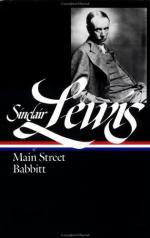She read in the records of the Minnesota Territorial Pioneers that only sixty years ago, not so far back as the birth of her own father, four cabins had composed Gopher Prairie. The log stockade which Mrs. Champ Perry was to find when she trekked in was built afterward by the soldiers as a defense against the Sioux. The four cabins were inhabited by Maine Yankees who had come up the Mississippi to St. Paul and driven north over virgin prairie into virgin woods. They ground their own corn; the men-folks shot ducks and pigeons and prairie chickens; the new breakings yielded the turnip-like rutabagas, which they ate raw and boiled and baked and raw again. For treat they had wild plums and crab-apples and tiny wild strawberries.
Grasshoppers came darkening the sky, and in an hour ate the farmwife’s garden and the farmer’s coat. Precious horses painfully brought from Illinois, were drowned in bogs or stampeded by the fear of blizzards. Snow blew through the chinks of new-made cabins, and Eastern children, with flowery muslin dresses, shivered all winter and in summer were red and black with mosquito bites. Indians were everywhere; they camped in dooryards, stalked into kitchens to demand doughnuts, came with rifles across their backs into schoolhouses and begged to see the pictures in the geographies. Packs of timber-wolves treed the children; and the settlers found dens of rattle-snakes, killed fifty, a hundred, in a day.
Yet it was a buoyant life. Carol read enviously in the admirable Minnesota chronicles called “Old Rail Fence Corners” the reminiscence of Mrs. Mahlon Black, who settled in Stillwater in 1848:
“There was nothing to parade over in those days. We took it as it came and had happy lives. . . . We would all gather together and in about two minutes would be having a good time—playing cards or dancing. . . . We used to waltz and dance contra dances. None of these new jigs and not wear any clothes to speak of. We covered our hides in those days; no tight skirts like now. You could take three or four steps inside our skirts and then not reach the edge. One of the boys would fiddle a while and then some one would spell him and he could get a dance. Sometimes they would dance and fiddle too.”
She reflected that if she could not have ballrooms of gray and rose and crystal, she wanted to be swinging across a puncheon-floor with a dancing fiddler. This smug in-between town, which had exchanged “Money Musk” for phonographs grinding out ragtime, it was neither the heroic old nor the sophisticated new. Couldn’t she somehow, some yet unimagined how, turn it back to simplicity?
She herself knew two of the pioneers: the Perrys. Champ Perry was the buyer at the grain-elevator. He weighed wagons of wheat on a rough platform-scale, in the cracks of which the kernels sprouted every spring. Between times he napped in the dusty peace of his office.
She called on the Perrys at their rooms above Howland & Gould’s grocery.




